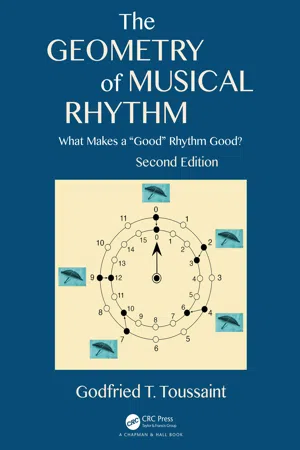
The Geometry of Musical Rhythm
What Makes a "Good" Rhythm Good?, Second Edition
- 352 pages
- English
- ePUB (mobile friendly)
- Available on iOS & Android
The Geometry of Musical Rhythm
What Makes a "Good" Rhythm Good?, Second Edition
About this book
The original edition of The Geometry of Musical Rhythm was the first book to provide a systematic and accessible computational geometric analysis of the musical rhythms of the world. It explained how the study of the mathematical properties of musical rhythm generates common mathematical problems that arise in a variety of seemingly disparate fields. The book also introduced the distance approach to phylogenetic analysis and illustrated its application to the study of musical rhythm. The new edition retains all of this, while also adding 100 pages, 93 figures, 225 new references, and six new chapters covering topics such as meter and metric complexity, rhythmic grouping, expressive timbre and timing in rhythmic performance, and evolution phylogenetic analysis of ancient Greek paeonic rhythms. In addition, further context is provided to give the reader a fuller and richer insight into the historical connections between music and mathematics.
Frequently asked questions
- Essential is ideal for learners and professionals who enjoy exploring a wide range of subjects. Access the Essential Library with 800,000+ trusted titles and best-sellers across business, personal growth, and the humanities. Includes unlimited reading time and Standard Read Aloud voice.
- Complete: Perfect for advanced learners and researchers needing full, unrestricted access. Unlock 1.4M+ books across hundreds of subjects, including academic and specialized titles. The Complete Plan also includes advanced features like Premium Read Aloud and Research Assistant.
Please note we cannot support devices running on iOS 13 and Android 7 or earlier. Learn more about using the app.
Information
CHAPTER 1
What is Rhythm?
Table of contents
- Cover
- Half Title
- Title Page
- Copyright Page
- Dedication Page
- Table of Contents
- Preface to the First Edition
- Preface to the Second Edition
- Author
- CHAPTER 1 ▪ What is Rhythm?
- CHAPTER 2 ▪ Isochrony, Tempo, and Performance
- CHAPTER 3 ▪ Timelines, Ostinatos, and Meter
- CHAPTER 4 ▪ The Wooden Claves
- CHAPTER 5 ▪ The Iron Bells
- CHAPTER 6 ▪ The Clave Son: A Ubiquitous Rhythm
- CHAPTER 7 ▪ Six Distinguished Rhythm Timelines
- CHAPTER 8 ▪ The Distance Geometry of Rhythm
- CHAPTER 9 ▪ Classification of Rhythms
- CHAPTER 10 ▪ Binary and Ternary Rhythms
- CHAPTER 11 ▪ The Isomorphism Between Rhythms and Scales
- CHAPTER 12 ▪ Binarization, Ternarization, and Quantization of Rhythms
- CHAPTER 13 ▪ Syncopated Rhythms
- CHAPTER 14 ▪ Necklaces and Bracelets
- CHAPTER 15 ▪ Rhythmic Oddity
- CHAPTER 16 ▪ Offbeat Rhythms
- CHAPTER 17 ▪ Rhythm Complexity
- CHAPTER 18 ▪ Meter and Metric Complexity
- CHAPTER 19 ▪ Rhythmic Grouping
- CHAPTER 20 ▪ Dispersion Problems: Perfectly Even, Maximally Even, and Balanced Rhythms
- CHAPTER 21 ▪ Euclidean Rhythms, Euclidean Strings, and Well-Formed Rhythms
- CHAPTER 22 ▪ Lunisolar Rhythms: Leap Year Patterns
- CHAPTER 23 ▪ Almost Maximally Even Rhythms
- CHAPTER 24 ▪ Homometric Rhythms and Crystallography
- CHAPTER 25 ▪ Complementary Rhythms
- CHAPTER 26 ▪ Flat Rhythms and Radio Astronomy
- CHAPTER 27 ▪ Deep Rhythms
- CHAPTER 28 ▪ Shelling Rhythms
- CHAPTER 29 ▪ Phase Rhythms: The “Good,” the “Bad,” and the “Ugly”
- CHAPTER 30 ▪ Phantom Rhythms
- CHAPTER 31 ▪ Reflection Rhythms, Elastic Rhythms, and Rhythmic Canons
- CHAPTER 32 ▪ Toggle Rhythms
- CHAPTER 33 ▪ Symmetric Rhythms
- CHAPTER 34 ▪ Rhythms with an Odd Number of Pulses
- CHAPTER 35 ▪ Visualization and Representation of Rhythms
- CHAPTER 36 ▪ Rhythmic Similarity and Dissimilarity
- CHAPTER 37 ▪ Grouping and Meter as Features of Rhythm Similarity
- CHAPTER 38 ▪ Regular and Irregular Rhythms
- CHAPTER 39 ▪ Evolution and Phylogenetic Analysis of Musical Rhythms
- CHAPTER 40 ▪ Rhythm Combinatorics
- CHAPTER 41 ▪ What Makes the Clave Son Such a Good Rhythm?
- CHAPTER 42 ▪ On the Origin, Evolution, and Migration of the Clave Son
- CHAPTER 43 ▪ Epilogue
- REFERENCES
- INDEX